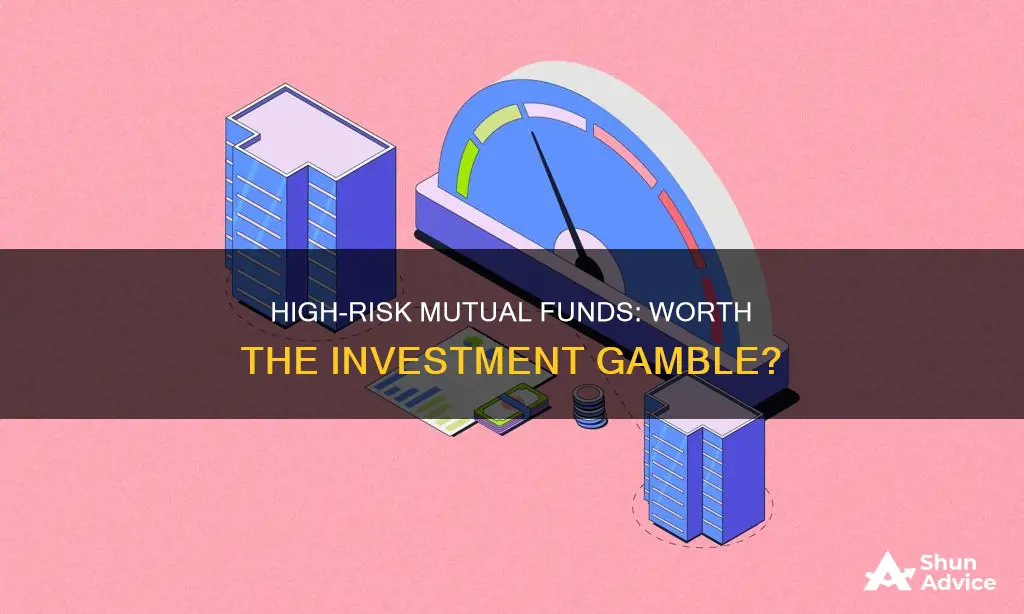
High-risk mutual funds are an investment option for those seeking substantial rewards and are willing to tolerate significant risk. These funds typically invest in volatile assets, such as stocks of emerging companies, commodities, or sectors experiencing significant growth or decline. While they offer the potential for high returns, investors also face the possibility of considerable losses. Due to their aggressive investment strategies, high-risk mutual funds are generally suited for investors with a strong risk appetite and a long-term investment horizon. Before venturing into these funds, it is crucial to assess your risk tolerance, financial objectives, and time horizon. Understanding the inherent volatility and conducting thorough due diligence are essential steps in the decision-making process.
What You'll Learn

High-risk mutual funds: pros and cons
High-risk mutual funds are investment funds that target high-growth companies, aiming for substantial returns. However, as the name suggests, these funds also carry a significant level of risk.
Pros
High-risk mutual funds offer several potential advantages:
- Higher Returns: These funds typically invest in volatile assets, such as stocks of emerging companies, which can generate higher returns over the long term compared to more conservative investments.
- Diversification: Some high-risk mutual funds spread their investments across a wide range of assets, including stocks, bonds, commodities, and real estate. This diversification can help reduce overall portfolio risk.
- Growth Opportunities: With a longer investment horizon, investors can benefit from compounding returns and ride out short-term market fluctuations.
- Access to Specialised Markets: These funds may provide exposure to niche sectors, such as technology, healthcare, or emerging markets, offering unique investment opportunities.
- Active Management: Many high-risk mutual funds are actively managed by experienced professionals who closely monitor market trends and adjust allocations, potentially leading to better investment decisions.
Cons
However, there are also several drawbacks and risks to consider:
- High Risk of Loss: The most significant downside is the high risk of losing value. These funds invest in volatile assets prone to market fluctuations, and there is a substantial probability of losing investments.
- Volatility: High-risk mutual funds are more volatile than other types, leading to significant fluctuations in the value of your investment over time.
- Long-Term Investment Horizon: These funds typically require a long-term investment commitment of at least 5-10 years to weather market ups and downs and realise potential gains.
- Liquidity Risk: Due to their sensitivity to market changes, high-risk mutual funds often face large short-term fluctuations, making it challenging for investors to liquidate their assets and exit the fund.
- Tax Implications: Investing in high-risk mutual funds can trigger tax consequences, such as Short-Term and Long-Term Capital Gains Taxes, which vary based on the holding period and type of fund.
Suitability
High-risk mutual funds are suitable for investors with a strong understanding of the market, a high-risk appetite, and a long-term investment horizon. It is crucial to assess your risk tolerance and financial goals before considering these funds.
Emerging Market Funds: Worth the Investment Risk?
You may want to see also

Who should invest in high-risk mutual funds?
High-risk mutual funds are not for the faint of heart. These funds are designed for investors with a strong risk appetite who are comfortable with short-term price fluctuations and volatility in returns. If you are a conservative investor, you may want to steer clear of these funds and opt for moderate-risk or large-cap mutual funds instead.
So, who should consider investing in high-risk mutual funds? Here are the key characteristics:
- In-depth knowledge: Investors suited for high-risk funds have a good understanding of the market and macroeconomic trends. They are well-informed about the risks and potential rewards of their investments.
- Strong risk appetite: High-risk funds are for those who are open to taking risks and are willing to expose their portfolio to volatility in pursuit of higher earnings. These investors are prepared for potential losses and are comfortable with the possibility of short-term price fluctuations.
- Long-term investment horizon: High-risk mutual funds typically require a long-term investment horizon, often extending up to 5-10 years. These funds are designed for investors who can remain patient and committed to their investment strategy despite market ups and downs.
- Aggressive but patient investment approach: Investors suited for high-risk funds often have an aggressive investment strategy, seeking above-average growth and outperformance compared to the broader market. At the same time, they also need to be patient, as these funds may take time to generate substantial returns.
- Ability to withstand losses: Investors in high-risk funds should carefully consider their capacity to absorb losses. Before investing, one should assess their financial situation and determine the scale of losses they can handle.
- Financial goals: High-risk funds are suitable for those with long-term financial goals, such as retirement planning, buying a home, or other significant milestones. These investors are willing to take on higher risk to achieve their financial objectives.
It is important to remember that high-risk mutual funds are not suitable for everyone. Investors should carefully consider their risk tolerance, financial goals, and investment horizon before deciding to invest in these funds. Conducting thorough research and, if necessary, consulting with a financial advisor is essential to making an informed decision.
Schwab S&P 500 Index Fund: A Smart Investment Choice
You may want to see also

What are the risks of high-risk mutual funds?
High-risk mutual funds are inherently volatile and prone to market fluctuations. They are considered to have a higher level of risk compared to other types of mutual funds. These funds typically invest in stocks of emerging companies, commodities, or sectors experiencing significant growth or decline. While high-risk mutual funds offer the potential for substantial rewards, they also come with elevated risks. Here are some key risks associated with high-risk mutual funds:
Market Risk and Volatility
High-risk mutual funds are extremely sensitive to market fluctuations, which makes their volatility high. These funds are prone to significant price fluctuations and losses in the short term. Investors need to be prepared for such volatility and assess the funds' implied volatility before investing.
Liquidity Risk
Due to their high sensitivity to market changes, high-risk mutual funds often face large short-term fluctuations. This liquidity risk makes it challenging for investors to liquidate their assets and exit the fund during periods of heightened volatility.
Loss and Negative Returns
Higher risk does not always translate to higher returns. High-risk mutual funds can experience losses or high volatility, as seen during market downturns. There is a significant risk of negative returns or price risk, and investors need to be comfortable with this possibility.
Credit Risk
High-risk mutual funds may invest in assets with less-than-optimal credit ratings, which can increase the risk of default. This credit risk should be considered, as it poses a chance of the company not fulfilling its obligations to bondholders.
Suitability for Aggressive Investors
High-risk mutual funds are generally suitable for investors with a strong risk appetite and an aggressive but patient investment approach. These funds require investors to be comfortable with volatility and potential short-term losses while seeking higher returns over the long term.
Long-Term Investment Horizon
High-risk mutual funds are typically designed for long-term investment horizons, often extending up to 5-10 years. Investors need to be prepared to stay invested for the long term to ride out market fluctuations and achieve their financial goals.
In summary, high-risk mutual funds carry a higher level of risk compared to other types of mutual funds. While they offer the potential for substantial rewards, investors should carefully consider the associated risks, including market volatility, liquidity issues, negative returns, credit risk, and the need for a long-term investment horizon. Conducting thorough due diligence and assessing one's risk tolerance and investment goals are crucial before investing in high-risk mutual funds.
Nippon India Multi-Asset Fund: Smart Investment Strategies
You may want to see also

What are the benefits of high-risk mutual funds?
High-risk mutual funds are funds that invest in volatile assets, such as stocks of emerging companies, commodities, derivatives, or sectors experiencing significant growth or decline. These funds are designed for investors who are willing to take on more risk in exchange for the potential for higher returns. While they carry a higher level of risk compared to other types of mutual funds, they also present several benefits. Here are some key advantages of investing in high-risk mutual funds:
Potential for Higher Returns:
High-risk mutual funds offer the possibility of substantial financial rewards. They target investors seeking higher returns than what can be achieved through more conservative investments. The allure of high-risk mutual funds lies in their potential for outsized returns, making them attractive to aggressive investors.
Diversification:
High-risk mutual funds provide diversification benefits, which help to reduce the overall risk of the investment portfolio. While some high-risk funds may concentrate on specific sectors or assets, others offer diversification across different sectors and asset classes, such as stocks, bonds, commodities, and real estate. This diversification can spread risk and potentially reduce portfolio volatility.
Long-term Capital Appreciation:
High-risk mutual funds typically perform well over the long term, with a time horizon of 5-7 years or more. They are suitable for investors with long-term financial goals and an aggressive but patient investment approach. These funds are designed to create wealth over time and are adept at generating inflation-adjusted returns.
Tax Benefits:
High-risk mutual funds can offer tax advantages, especially for investors in higher income tax brackets. They may provide more tax-efficient returns compared to traditional bank fixed deposits. Additionally, long-term capital gains from high-risk mutual funds may be taxed at a lower rate than short-term gains.
Professional Management:
High-risk mutual funds are managed by seasoned fund managers who possess expertise in investing in high-growth companies. These professionals have a deep understanding of the markets and the skills to drive returns for investors. Their active management can potentially lead to better investment decisions and improved performance compared to passively managed funds.
Access to Specialised Markets:
High-risk mutual funds provide investors with exposure to specialised markets or sectors that may not be easily accessible through traditional investments. These sectors include technology, healthcare, emerging markets, or commodities. This allows investors to capitalise on niche opportunities and potentially generate higher returns.
It is important to note that high-risk mutual funds are not suitable for everyone. Investors should carefully consider their risk tolerance, investment goals, and time horizon before investing in these funds. Conducting thorough research and due diligence is essential before making any investment decisions.
A Guide to Investing in ICICI Liquid Funds
You may want to see also

How to choose the right high-risk mutual fund?
High-risk mutual funds are not for the faint-hearted. They carry a higher risk of loss but also offer the potential for higher returns. If you are considering investing in high-risk mutual funds, here are some key factors to help you choose the right one:
- Investment Objective and Risk Tolerance: Clearly define your financial goals and risk tolerance. Are you investing for retirement, education, or wealth creation? High-risk mutual funds are generally designed for investors with a long-term investment horizon who are willing to accept volatility in returns.
- Fund Type and Category: Mutual funds can be categorized as equity funds, debt funds, or hybrid funds. Equity funds are typically riskier but offer higher potential returns. Debt funds are considered safer and are suitable for conservative investors. Hybrid funds provide a mix of equity and debt, offering a balance between risk and return.
- Performance and Track Record: Evaluate the fund's performance over the last 3, 5, and 10 years. Compare its returns with its benchmark and peer group. While past performance doesn't guarantee future results, consistency in outperforming its peers and the market can be an indicator of a good fund manager.
- Expense Ratio: The expense ratio is the annual fee charged by the mutual fund for managing your money. A lower expense ratio means a higher return for you. However, also consider the quality of services provided by the fund.
- Exit Load: The exit load is the fee charged when you sell units of the mutual fund. A fund with no or minimal exit load will maximize your net returns.
- Tax Implications: Understand the tax treatment of the fund. Different types of mutual funds have different tax implications. For example, equity funds in India are typically taxed at 15% for short-term capital gains and 10% for long-term capital gains (over one year).
- Direct vs. Regular Plans: Direct plans allow you to invest directly without intermediaries, resulting in a lower expense ratio. Regular plans involve third-party agents and have a higher NAV and lower returns.
- Fund Manager Performance: Analyze the fund manager's track record and their expertise in investing in high-growth companies.
- Liquidity: Consider the liquidity of the mutual fund, including features such as the lock-in period, exit load, and redemption limits. Choose a fund that offers flexibility to withdraw your money when needed.
- Investment Strategy: Understand the fund's investment strategy, such as growth, dividend, or index. Choose a fund that aligns with your investment style and preferences.
- Diversification: High-risk mutual funds may invest in a range of assets, including stocks, bonds, commodities, and real estate. Diversification can help spread risk and reduce overall portfolio volatility.
- Time Horizon: Different mutual funds are suitable for different investment horizons. For example, equity funds are typically recommended for investment periods exceeding five years due to their potential for significant returns.
Remember, investing in high-risk mutual funds is not suitable for everyone. Always assess your financial goals, risk tolerance, and investment horizon before making any investment decisions.
A Beginner's Guide to Mutual Fund Investing
You may want to see also
Frequently asked questions
High-risk mutual funds are funds that invest in volatile assets, such as stocks of emerging companies, commodities, or sectors experiencing significant growth or decline. These funds carry a higher risk of loss but also offer the potential for substantial rewards.
High-risk mutual funds are suitable for investors with a strong risk appetite and an aggressive but patient investment approach. These investors should have a good understanding of the market and macroeconomic trends and be comfortable with short-term price fluctuations and losses.
High-risk mutual funds offer the potential for higher returns over the long term, typically 5-10 years. They provide an opportunity for substantial wealth creation and can help investors achieve above-average growth, outperforming the broader market. Additionally, these funds offer diversification benefits, professional management by seasoned fund managers, and tax advantages for higher-income individuals.







